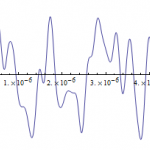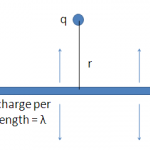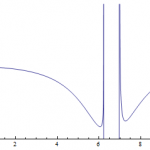
There was an xkcd feature a while back which asked the question "If everyone in the world shined a laser pointer at the moon at the same time, would we be able to see it?"
The answer was no. A laser pointer doesn't put out much light, and even seven billion of them doesn't represent a whole lot when spread over vast areas of the lunar surface a quarter million miles away. Even if you ramp up the light source to those helicopter-grade searchlights, no dice.
On the other hand, it's asking a lot for a beam of light to make it to the moon, bounce off in all directions including mostly into empty…
By now everyone's heard of Felix Baumgartner and his record-breaking leap out of a balloon some 24 miles over the New Mexico desert. While the "official" definition of outer space is generally considered to start at either 60 miles or 100 kilometers, Felix's leap of some 39,045 meters is in many respect a drop from outer space. He was above essentially all of the atmosphere, the daylight sky above him was a black starry void, and he had to wear a spacesuit to breathe.
So why didn't he burn up on re-entry? The physics-savvy among you may scoff at such a question, but it's one that a lot of…
Over the last two days we've talked about hash functions and their uses in cryptography and elsewhere. Remember that an ideal hash function is basically what cryptographers call a random oracle - given an input, it produces a random number in some range. (In practice this range is always [0,2^(2^n)], with n usually equal to 5 or 6 for non-cryptographic hashes or n equal to 7, 8, or 9 for cryptographic hashes.) This random number is deterministic, in that the same input always produces the same output. But the output is otherwise unpredictable. Given an output, it should not be possible to…
Yesterday we looked at hash functions. As you recall, they're functions which take an input and generate a random-seeming output. As a quick example, here's the output of the SHA-256 hash function for the name of the Scottish physicist James Maxwell and a misspelling thereof:
SHA256("James Clerk Maxwell") = 2667629603913530690117759428994407894024237387971995154086108064226397\
5353322
SHA256("James Clark Maxwell") = 9129664885155451589341762461551711693832872424126676652783015499131718\
4589063
A tiny change in the input generates a wildly different output, so tt looks like SHA256 is a…
Last week NIST anounced the winner of its Cryptographic Hash Function Competition. After five years of review and many rounds of discussion and elimination, the winner is a hash function called Keccak, and its developers deserve many congratulations. It's a shame hash functions aren't better known in the general public, because not only are they a vital part of keeping data safe online, they're one of the most interesting bits of applied math. Better still, their basic concept is not complicated at all.
Hash functions are so cool, in fact, that I want to spend several posts this week…
Hey, how about that! Three people in our optics group here at Texas A&M (Professor Alexei Sokolov, postdoc Miaochan Zhi, and grad student Kai Wang) had a photograph from one of their optics experiments make the Optics and Photonics News Image of the Week:
Image of the Week: Raman sidebands from a femtosecond pulse
The crystal in the foreground is being hit by two pulses of light, which interact with the material and each other in such a way as to form numerous other beams with different wavelengths, forming the rainbow of discrete beams seen in the photograph.
This is an effect which…
There's this grim and affecting scene in both X-Men and X-Men: First Class - a young Erik Lehnsherr watches his family hauled away by Nazis through the gates of a concentration camp. He's being dragged away by the Nazi guards, and he uses his magnetic powers for the first time to grab the gates with his burgeoning magnetic powers. The combined efforts of the guards aren't sufficient to pry him loose and they finally have to club him over the head. We'll call this Comic Book Physics Paradigm 1:
Paradigm 1: Newton's 3rd Law
Later on, as the adult Magneto, he shoves around gigantic satellite…
In most books or articles that talk about lasers, you'll see a definition of laser light in terms of "coherence". But coherence is sort of a term of art, and the books will go on to explain coherence in terms of the waves being in sync with each other, or the emitted light being very monochromatic, or something else slightly vague.
This is all pretty good as far as it goes, but we'd like to do a little better. (Though for this post, not much math. But don't get too comfortable!) The word "coherence" means something like "holding together", and this is actually a pretty good description of the…
Back before my now-ended blogging hiatus, the server machinery that keeps ScienceBlogs running was not so snazzy as it is now. Now it's running a WordPress implementation that includes LaTeX support. LaTeX is a free environment for (among other things) typesetting mathematics. Let's give it a test run:
$latex 3 = \sqrt{6+\sqrt{6+\sqrt{6+\cdots}}} &s=2$
I actually came across the above expression in a Mathematica book, which used it as an example of how Mathematica could do typesetting. It didn't include anything other than the expression - no proof or anything else. We might as well test…
If you've been reading ScienceBlogs for a while, you might remember this little physics blog I used to write. It and I sort of vanished off the internet for a long while. More than a year, I'm sad to say. Long story short, being a grad student takes up a huge amount of time. While I sort of thought being done with classes and going to pure research would give me some breathing room, it did the opposite. Also, I got married. Being married is nice. But did it add to my quantity of free time? It did not. And after a while of not doing something which is not mandatory - like writing a blog - you…
Boy howdy do we love spheres in physics. Sure we might tell you that the reason involves deep truths in topology, and symmetry, and group theory, and all that mathematical arcana, and in fact there's a lot of truth to that. But if we're completely honest, or at least if I'm completely honest, I have to admit that I love spheres because they're easy. All that lovely deep symmetry tends to produce enormous simplifications in whatever actual calculations we happen to do involving spheres.
Hence, our love for pretending everything is a sphere, or at least close enough for govermnemt work. There's…
A reader asked me about the hyperbolic trig functions, sinh(x) and cosh(x). What are they for, and do they have an intuitive interpretation in physics?
That's a pretty good question. After all, most of the time you first meet the hyperbolic trig functions in intro calculus, where their rather odd definitions are presented and then used as test beds for blindly applying newly-learned differentiation rules. Ok, great. But what are they really?
To answer the question, we should start off with Euler's identity, which relates the exponential function with the regular trig functions. Proving this…
Our department here at Texas A&M has a student chapter of the Optical Society of America, and each week a student or professor gives a talk about something interesting while the rest of us eat pizza. I've been working on and off on a talk I'm going to give, tentatively titled "Just what the @#$% is a photon anyway?". The more I dig into the subject, the more I start to think that (like the rubber-sheet analogy in GR) the "particles of light" view that tends to be the common impression tends to cause more confusion than enlightenment. I have some good company here - E.T. Jaynes wrote a…
By the 1860s, the classical theory of electricity and magnetism was on a very solid theoretical footing. Maxwell's equations describing the interplay of charges and currents with electric and magnetic fields were on paper by 1862, and with some changes in notation they're the exact same today. Relativity wouldn't be invented for another half-century or so, and that makes it all the more remarkable that Maxwell's equations don't actually need to be modified at all to work in a relativistic framework. Lorentz covariance is built right in, though it's a bit hidden.
But Maxwell and Faraday and…
Phil at Bad Astronomy opined (and it is a common opinion) that the supernatural is incoherent:
If you posit some thing that has no perceivable or measurable effect, then it may as well not exist. And as soon as you claim it does have an effect -- it can be seen, heard, recorded, felt -- then it must be in some way testable, and therefore subject to science.
Joshua was not so sure about this. The supernatural could, perhaps, interact observably with the universe at some times but not at others. Under normal circumstances the normal laws apply, under others, supernatural stuff happens. Chad…
Head down to Box Office Mojo and pull up the list of the top grossing films of the year thus far. Seven of the top ten have a dollar gross beginning with the number 1. Okay, that's not too weird. Big films tend to pull down somewhere between $100-200 million, while only the real monsters have high grosses. So what if we look at the inflation-adjusted all-time list, which is less likely to be fixed by the coincidental size of the film-going public and ticket prices? Again, seven of the 10 have grosses beginning with 1.
Well, maybe movies are just weird. What about cities? In the US, five of…
Here is a picture of (I think) Maru the cat playing in a bag. He loves bags.
Here is the same picture of Maru, at half the size:
Now imagine that Maru is a physicist and the pictures are not pictures but instead windows into the universe he occupies, separate from ours with (possibly) its own unique set of physical laws. The only difference between the two universes is that one has the lengths of everything reduced by a factor of 2.
Can the parallel versions of Maru tell which universe they're in - the smaller or the larger? Or if you want to imagine what you might do, suppose that in some…
Just though I'd try writing a post title in the style of a crank. Kinda fun!
Gauss' law, of course, is not wrong. But I got a question from a reader that deceptively simple and an interesting example of a theorem not quite working the way you'd expect. I've gone over Gauss' law before, so as a quick refresher I'll just say that it relates the electric charge at a location to the way the electric field lines diverge at that location. Symbolically (and in, appropriately, Gaussian units):
E is the electric field, ρ is the charge density. Draw a closed surface around the charge in question and…
Some initial thoughts, on a beautiful day in a palpably better world without Osama:
1. I'm astonished he was still alive. I was certain he died from an anonymous bomb or health problems sometime between '01 and '04. He hadn't released any tapes or videos with unambiguous confirmation of when they were recorded, and the general consensus was that al-Qaida was now a fully decentralized organization that had adjusted to operating without him. The fact that he wasn't dead meant that, unlike his suicide bombers and guerrillas, he had basically abandoned his own cause to live in (very) quiet luxury…
Last time we took a pulse of light and shot it through a medium with a frequency-dependent refractive index. The particular form of the refractive index was sort of interesting - for some frequencies, it was less than 1. That implied that the phase velocity of a sine wave would be faster than the speed of light. But pulses of light contain a band of frequencies so normally we'd invoke the group velocity to show that the pulse as a whole propagates with a speed less than c. For reference, here's the refractive index curve we postulated:
We can't do that group velocity jazz here. Take a look.…










